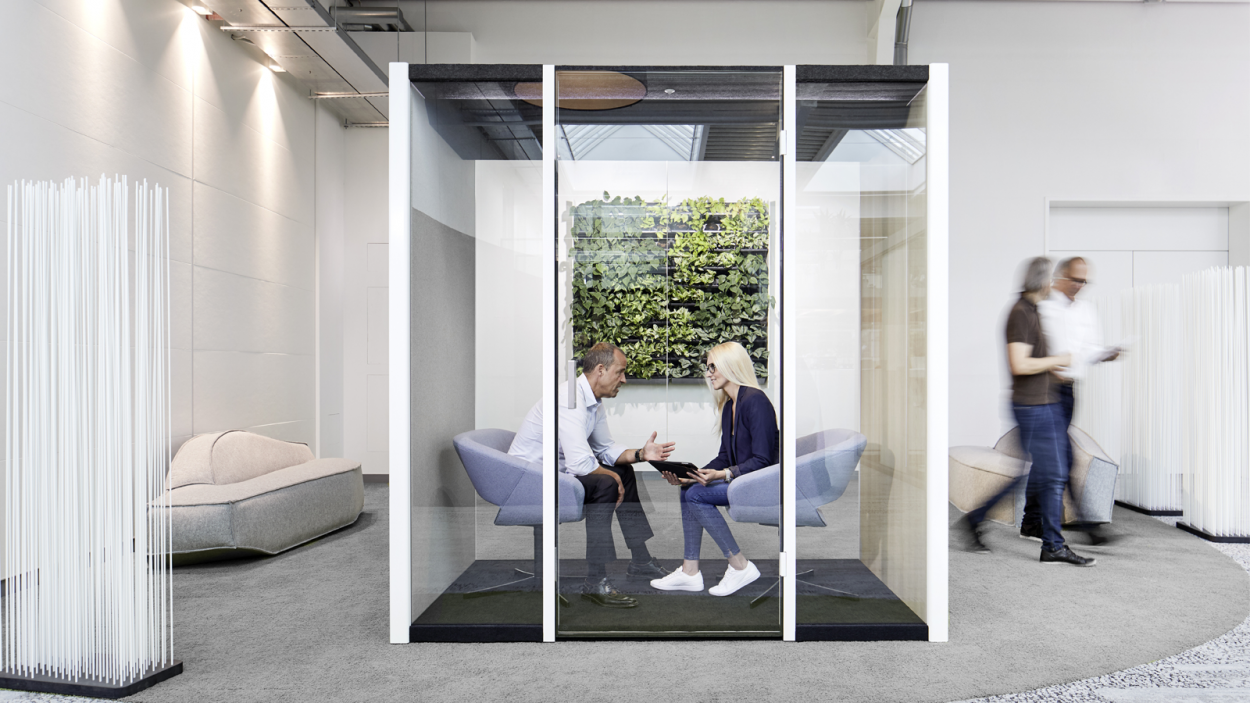Foster Well-Being in the Workplace by Designing for People
As we delve into the realm of work, it's the connections we forge that amplify our experiences and fuel our growth.
Are hybrid working environments a good choice across all industries? Work from home, work in the office or hybrid work - discover the pros and cons in this article.
Due to recent events, hybrid work is emerging as a more flexible way of working, promising advantages and facilitating employment retention. But is it the most viable option for everybody? While there is an array of benefits for both employers and employees, particularly in tech-based design and architecture, hybrid work is multifaceted and it is important to deliberate the pros and cons before deciding if it is right for your company.
What is Hybrid Work?
Hybrid is, by definition, a mixture of two elements. What this means for the workspace can also be interpreted in two ways - the first, the possibility to adapt schedules according to the different chronotypes that your employees present, and the second, the increase in flexibility with regards to working from home or attending the office.
This can only be good news for many of us who have been striving for better work-life balance. The status quo has remained unchanged for years. Nine to five in the office has been the way of the world for most of our working lives, and may have continued to be the accepted norm if it hadn’t been for Covid-19. With the absolute necessity to keep our economy in motion during the pandemic, we have been forced to adapt our way of working.
The Good
Hybrid working provides a wealth of opportunities for both employers and employees. Many of the advantages posed could also be considered disadvantages for some people, but with the increased flexibility that hybrid work promotes, teams are able to choose which aspects work in their favor and which might need to be considered from a different angle.

The Bad
Hybrid work is not a one-size-fits-all solution. There are aspects of flexible working on individual schedules that can have a detrimental effect on the company dynamic, so it is important to consider these implications before establishing a system for your organization.
The Ugly
Most of the potential disadvantages can be ironed out with excellent leadership skills, smart space organization and software that allows teams to check each other’s schedules and collaborate remotely. But there are more covert pitfalls to hybrid working which require change in order to mitigate them. Possibly the most predominant ugly face of hybrid work is inequality. Flexible work risks exacerbating pre-existing inequalities. When it comes to gender and race, hybrid work needs to be approached carefully so as not to facilitate exclusion.
Work from home looks set to be a standard practice for many companies as we exit the grasp of the pandemic, which has exacerbated long-standing gendered lines in which women do the bulk of the caregiving. The pandemic has brought yet more research into the spotlight that suggests that it is women who bear the brunt of domestic duties and childcare when working from home, even when their partners are in similar professional positions. The result of this on a woman’s professional trajectory can be devastating, and based on the estimated data from caregiver.org, that could affect 66% of our workforces.
‘The Digital Divide,’ as explained in this article from Clockwise´s blog, is another covert form of inequality. In the article, they say that “Lack of Broadband has shut 23 million Americans out of remote job interviews, Zoom classrooms and telemedicine.”
Race is another consideration. According to this article from Worktango, black households have 20% more people and Latinx households have 80% more people living under one roof than white households. Converting the home into an office space that nurtures creativity and productivity might then be more feasible for some than for others, giving way to a racial divide in hybrid working scenarios.
So, is hybrid work right for your organization?
Depending on the nature of your company, hybrid working can offer the flexibility needed to provide a healthier working environment, insofar as adapting to worker’s most productive working times thus reducing stress. If it were as clear-cut as this, hybrid working would undoubtedly be the best option for most of us. But it is important to consider the possible setbacks that these same working conditions can give rise to.

Logistical challenges mean an increase in the workload for organizers, but that does not mean they are challenges that can’t be overcome. As with any structural change, there is a period of adaptation which many are reluctant to embrace, but finally come round to the idea. The key to effective change is communication and organization - talk with your team and come up with the logistical solutions together. This way everybody’s voice is heard and you can avoid conflict further down the line.
Finally, equality needs to be addressed when considering the implementation of hybrid working for your company, as work from home may intensify the gender and race gap already noticeable across working America.
Sources compilation
Caramela, Sammi. "Working from home increases productivity." Business News Daily. March 31, 2020 https://www.businessnewsdaily.com/15259-working-from-home-more-productive.html#:~:text=Working%20From%20Home%20Increases%20Productivity&text=According%20to%20one%20study%2C%20remote,weeks%20of%20work%20per%20year
Everett, Cath. "The Future of Work's diversity challenge - prevent hybrid working models from fuelling a gender imbalance ." Diginomica. April 5, 2021 https://diginomica.com/future-works-diversity-challenge-prevent-hybrid-working-models-fuelling-gender-imbalance
Fowell, Tiffany. "Hybrid work: what is hybrid work and why do employees want it?” Envoy. July 7, 2021 https://envoy.com/blog/what-is-a-hybrid-work-model/#:~:text=Hybrid%20work%20gives%20employees%20more,work%20from%20a%20remote%20location
Ibarra, Herminia; Gillard, Julia and Chamorro-Premuzic, Tomas. “Why WFH Isn’t Necessarily Good for Women.” Harvard Business Review. July 16, 2020 https://hbr.org/2020/07/why-wfh-isnt-necessarily-good-for-women
Parker, Sharon K., Knight, Caroline and Keller, Anita. “Remote managers are having trust issues.” Harvard Business Review. July 30, 2020 https://hbr.org/2020/07/remote-managers-are-having-trust-issues
Reisenwitz, Cathay. “WFH will deepen income inequality, unless we do these four things.” Clockwise. September 10, 2021 https://www.getclockwise.com/blog/wfh-will-deepen-income-inequality-unless-we-do-these-four-things
Shinnan, Stephen. “Just how fair is remote work?” Worktango. December 5, 2020https://worktango.com/2020/12/05/just-how-fair-is-remote-work/
“Hybrid-Remote: understanding nuances and pitfalls.” Gitlabhttps://about.gitlab.com/company/culture/all-remote/hybrid-remote/
As we delve into the realm of work, it's the connections we forge that amplify our experiences and fuel our growth.
Explore blended spaces for remote work and how Dauphin's ergonomic seating options can help your employees stay comfortable and productive.
Using flexible furniture in your office can help you and your co-workers adapt to the needs of the ever-changing workspaces. Click to Configure